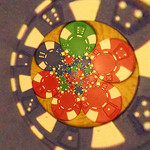1.1 No sooner had Paco arrived than he went to the hotel
- Sentences with negative adverbs or phrases (seldom, no sooner, at no time, not only, etc.). Why don't you have a look at all the examples in the previous section before going on?
- Conditional sentences.
In order to learn the main uses of inversion in English, click on the picture below.

|
| Imagen en Flickr de fdecomite bajo CC |
However, it is possible that with the short explanation above you think that it is not enough. If you think so, click on the pictures below in order to learn more about the topic before doing some activities to practise.
Now, it is time to add some exercises to the previous grammar. In some of the links below not only will you find some more grammar explanations but also some exercises to practice.
 |
| By Martyman. GNU Free Documentation License |
1. He has never had a better time before.
Never a better time before.
2. Paco not only studies History but he also English.
Not History but also English.
3. He hardly ever visited his brother in Madrid.
Hardly his brother in Madrid.
4. He got astonished as soon as he entered the library.
No sooner the library than he got astonished.